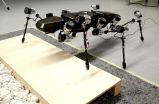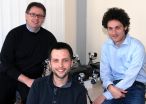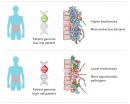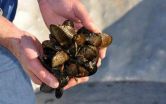First steps for Hector the robot stick insect
Scientists at Bielefeld University apply technology inspired by examples in nature
2014-12-16
(Press-News.org) This news release is available in German.
A research team at Bielefeld University has succeeded in teaching the only robot of its kind in the world how to walk. Its first steps have been recorded in a video. You can watch them in Bielefeld University's latest posting on 'research_tv'. The robot is called Hector, and its construction is modelled on a stick insect. Inspired by the insect, Hector has passive elastic joints and an ultralight exoskeleton. What makes it unique is that it is also equipped with a great number of sensors and it functions according to a biologically inspired decentralized reactive control concept: the Walknet. By 2017, the walking robot will be equipped with additional abilities in a major project at the Center of Excellence Cognitive Interaction Technology (CITEC).
The walking robot has been built by the Biomechatronics research group. In the future, Hector should serve as a platform for biologists and roboticists to test hypotheses about animal locomotion. One major aspect will be the fusion of large amounts of data from sensors so that the robot can walk more autonomously than before. A further key issue will be the optimal coordination of movements by a robot with elastic drives.
'The way that the elasticity in Hector's drives acts is comparable to the way that muscles act in biological systems,' says Professor Dr. Axel Schneider. He is heading the Biomechatronics research group and is coordinating the CITEC project together with Professor Dr. Volker Dürr from the Department of Biological Cybernetics at the Faculty of Biology. Schneider and his team developed the elastic joint drives themselves. Hector has 18 such joints. Through the biologically inspired elasticity of the drives, Hector can adapt flexibly to the properties of the surfaces over which it is walking.
'However, elasticity alone is not enough for Hector to be able to walk through a natural environment containing obstacles,' says Schneider. 'The challenge was to develop a control system that would coordinate the movements of its legs in difficult surroundings as well.' Schneider's colleague Jan Paskarbeit was responsible for developing and building the robot. He also programmed a virtual version of Hector in order to test experimental control approaches without damaging the robot. 'All sub-systems have to communicate with each other for the robot to walk without any difficulties,' says Paskarbeit. 'Otherwise, for example, Hector might have too many legs in the air at one time, become unstable, and fall over. Moreover, the legs have to be able to react to collisions with obstacles. We have dealt with this by implementing a reflex behaviour for climbing over objects,' explains the CITEC researcher.
At the CITEC Center of Excellence, eight research groups have joined together for three years in a large-scale project to optimize Hector. The scientists come from the fields of computer science, biology, physics, and engineering. Currently, the researchers are working on equipping Hector's front section with far-range sensors as in a head. They already have a prototype with two lateral cameras and two tactile feelers. Both the visual and the tactile systems are inpired by those of insects - their work spaces and their resolutions are similar to those of animal models. 'A major challenge will now be to find an efficient way to integrate these far-range sensors with the posture sensors and joint control sensors. Hector is the ideal research platform on which to do this,' says Volker Dürr.
The research on Hector is the outcome of a series of earlier research projects. For example, the functional parts for Hector were manufactured in the CITEC project 'MULERO' and in the project 'ELAN'. 'ELAN' was financed by the Federal Ministry of Education and Research. In the EU project 'EMICAB', Axel Schneider's and Volker Dürr's teams collaborated with three further European teams engaged in research on intelligent motion control in insects and robots. For Dürr and his team, this involved evaluating motion sequences in stick insects in order to understand the control mechanisms in the insect's nervous system and transfer these to computer models. A further stage in the construction of the robot was the design and manufacture of the robot body. A green and white design model was developed with designers from the Folkwang University of the Arts in Essen and engineers at the Leibniz Institute of Polymer Research in Dresden. The casing of the robot is now black, because it is made of carbon-fibre-reinforced plastic (CFRP) to save weight.
The CITEC Center of Excellence is spending 740,000 Euros on the current Hector major project entitled 'Embodied Interaction as a Core of Cognitive Interaction'.
INFORMATION:
Further information is available online at:
Video of Hector on research_tv („Eine Roboter-Stabheuschrecke lernt laufen"):http://youtu.be/1DB6bd61i0o
A Robot with Consciousness (CITEC news from 13.01.2014): http://www.cit-ec.de/node/9707
Stick insects as a model for intelligent motion control in robots (CITEC news from 8.2.2011): http://www.cit-ec.de/node/2829
Hector. The six-legged walking robot (Video): http://youtu.be/9pbqSrXLKGI
Contact:
Prof. Dr. Axel Schneider, Bielefeld University
Center of Excellence Cognitive Interaction Technology (CITEC)
Telephone: 0521 106-5163
Email: axel.schneider@uni-bielefeld.de
Prof. Dr. Volker Dürr, Bielefeld University
Faculty of Biology
Telephone: 0521 106-5528
Email: volker.duerr@uni-bielefeld.de
[Attachments] See images for this press release:


ELSE PRESS RELEASES FROM THIS DATE:
2014-12-16
DURHAM, N.C. - Duke University scientists have developed new forensic tracers to identify coal ash contamination in water and distinguish it from contamination coming from other sources.
"These new tools can be used by federal and state regulatory agencies to monitor the environmental effects of coal ash and determine whether it has or hasn't impacted the environment," said Avner Vengosh, professor of geochemistry and water quality at Duke's Nicholas School of the Environment. "They can be used to trace the coal ash effluents to their source, even in watersheds where ...
2014-12-16
Washington, D.C.--New work from Carnegie's Ivan Naumov and Russell Hemley delves into the chemistry underlying some surprising recent observations about hydrogen, and reveals remarkable parallels between hydrogen and graphene under extreme pressures. Their work is the cover story in the December issue of Accounts of Chemical Research.
Hydrogen is the most-abundant element in the cosmos. With only a single electron per atom, it is deceptively simple. As a result, hydrogen has been a testing ground for theories of the chemical bond since the birth of quantum mechanics ...
2014-12-16
MINNEAPOLIS/ST. PAUL (12/16/2014)--A new study by an international team of researchers shows for the first time that people may inherit some of the intestinal bacteria that cause Crohn's disease and ulcerative colitis, collectively know as inflammatory bowel disease (IBD). The study, recently published in Genome Medicine, also confirmed that antibiotics could worsen the imbalance in the gut microbes.
About 1.6 million Americans suffer from Crohn's disease or ulcerative colitis, according to the Crohn's and Colitis Foundation of America. Understanding the causes of these ...
2014-12-16
AMHERST, Mass. - In a follow-up to her earlier studies of learning in infancy, developmental psychologist Lisa Scott and colleagues at the University of Massachusetts Amherst are reporting that talking to babies in their first year, in particular naming things in their world, can help them make connections between what they see and hear, and these learning benefits can be seen as much as five years later.
"Learning in infancy between the ages of six to nine months lays a foundation for learning later in childhood," Scott says. "Infants learn labels for people and things ...
2014-12-16
WASHINGTON, DC--December 16, 2014--Using mathematical modeling, researchers at New York and Vanderbilt universities have shown that commensal bacteria that cause problems later in life most likely played a key role in stabilizing early human populations. The finding, published in mBio®, the online open-access journal of the American Society for Microbiology, offers an explanation as to why humans co-evolved with microbes that can cause or contribute to cancer, inflammation, and degenerative diseases of aging.
The work sprung from a fundamental question in biology ...
2014-12-16
INDIANAPOLIS -- In the first real-world trial of the impact of patient-controlled access to electronic medical records, almost half of the patients who participated withheld clinically sensitive information in their medical record from some or all of their health care providers.
Should patients control who can see specific information in their electronic medical records? How much control should they have? Can doctors and other clinicians provide safe, high-quality care when a patient's preference may deny members of the medical team from seeing portions of the electronic ...
2014-12-16
BALTIMORE, MD (Dec. 16, 2014)--With a unique, multi-faceted approach, researchers at the Lieber Institute for Brain Development (LIBD) have quantified the effect of previously unidentified anomalies in genetic expression that determine how the human brain develops from its earliest stages. Their work, published online December 15th in Nature Neuroscience, offers a novel technique for identifying biological markers in brain development that associate with risk for neurodevelopmental disorders such as schizophrenia and autism spectrum disorder (ASD).
Using state-of-the-art ...
2014-12-16
The mortality of larval Pacific oysters in Northwest hatcheries has been linked to ocean acidification. Yet the rate of increase in carbon dioxide in the atmosphere and the decrease of pH in near-shore waters have been questioned as being severe enough to cause the die-offs.
Now, a new study of Pacific oyster and Mediterranean mussel larvae found that the earliest larval stages are sensitive to saturation state, rather than carbon dioxide (CO2) or pH (acidity) per se.
Saturation state is a measure of how corrosive seawater is to the calcium carbonate shells made by ...
2014-12-16
Being "average" is often considered a bad thing, but new research suggests that averageness wins when people assess the trustworthiness of a face. The research indicates that, while typical-looking faces aren't seen as the most attractive, they are considered to be the most trustworthy. The new findings are published in Psychological Science, a journal of the Association for Psychological Science.
"Face typicality likely indicates familiarity and cultural affiliation - as such, these findings have important implications for understanding social perception, including cross-cultural ...
2014-12-16
ITHACA, N.Y. - Since 1998, hundreds and sometimes thousands of dead eider ducks have been washing up every year on Cape Cod's beaches in late summer or early fall, but the reasons behind these cyclic die-offs have remained a mystery.
A team of scientists from Cornell, Tufts University, University of Georgia, the U.S. Geological Survey and the U.S. Fish and Wildlife Service have pinned down one of the agents responsible: a pathogen they're calling Wellfleet Bay virus (WFBV). Their findings shed light on why eider ducks (also called common eiders) die on Cape Cod every ...
LAST 30 PRESS RELEASES:
[Press-News.org] First steps for Hector the robot stick insect
Scientists at Bielefeld University apply technology inspired by examples in nature







